What are underrun heels?
by Andrew Bowe
Underrun heels are when the angle of the heel wall is less than that of the toe wall (fig 1).
This is one of the most prevalent deformities found in the feet of domestic horses, particularly thoroughbreds that have been through the racing industry – which accounts for most of the pleasure horse industry! This scenario sets up a fundamental weakness that affects the integrity of the entire hoof capsule.
In a normal, healthy hoof capsule, when the heel angle is steeper than the toe, the inherent strength of the cone is intact (fig 2). This means when the heel slams the ground on landing, the steeper angle is able accommodate the impact – one of the great strengths of equine feet.
When the angles pass the other way, the cone in effect becomes inverted and loses the inherent strength (fig 1). So when the foot slams the ground heel first, it has the effect of squashing the heel. There is no other possible outcome. Underrun heels can be diabolical for horses. The crushing of the entire soft tissues in the caudal foot can produce enough soreness for the horse to choose to land on its toes which sets up a vicious cycle of further inflammation, particularly in the navicular area (fig 3); thus giving birth to possible future navicular disease as well as the insidious effects of pedal bone loss via osteitis.
What causes Underrun heels to begin?
Underrun heels are mostly the result of loss of function when shoes are applied, particularly the raising of the frog off the ground. This combined with the forward growing action of the hoof capsule when it is prevented from wearing, simply forces the heels to collapse forwards and under. Of course these bad mechanics are exacerbated by short shoeing (done to avoid shoe loss) or leaving too long between re-shoeing (fig 4).
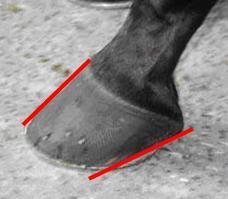
Fig 1
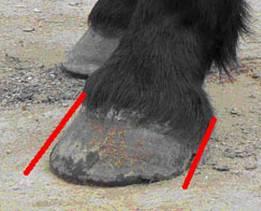
Fig 2
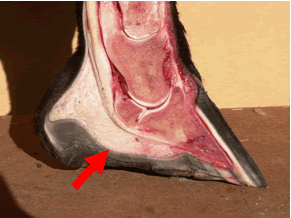
Fig 3
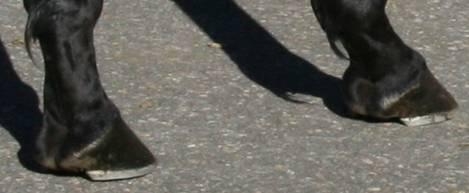 Fig 4
Fig 4
How can we manage Underrun heels?
The basis of management is to try and return the heels to a position that is more centrally beneath the centre of gravity of the limb. Underrun heels cannot be considered in isolation because they are virtually always accompanied by a run forward toe, often seen as a flared toe (in fact it has quite appropriately been labeled “forward foot syndrome”)(fig 5). We need to treat the whole hoof capsule- heel, toe and quarters.
Firstly, the toe needs to be dressed so that the breakover balance is optimal and there is no lever force remaining that acts to drag the heel forward (fig 6).

Fig 5
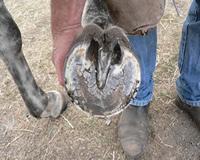
Fig 6
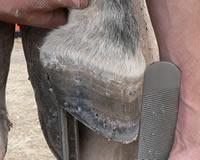
Fig 7
Secondly, the heel platforms may be able to be firstly, lowered and secondly, shaped in the caudal half to further enhance the base of support (fig 7).
Thirdly, the quarters need to be made passive and kept passive so that any pushing up through the coronary band can be released (fig 6).
The real value of maintenance trimming becomes apparent with underrun heels because the key to solving the deformity is keeping the feet constantly in optimal balance.
Can we always fix underrun heels?
Unfortunately, underrun heels can’t always be rectified, sometimes it can only be managed. Like so many other ailments of domestic horses prevention is ultimately the best cure.
The fly in the ointment is the lack of substance in the landing gear which all too often accompanies underrun heels. Weakened heels cannot possibly ‘stand up’ without a strong and thick frog and digital cushion to predominantly carry the load.
More often than not, rehabilitation is only initiated by correct trimming. Full rehabilitation is only completed by the development of a thicker and more robust frog and digital cushion; a result of correct and adequate movement over hard terrain. It’s all about giving them a lifestyle that meets their evolutionary requirements. It gets said so often that that the best feet are made, not trimmed.
Can underrun heels be permanent?
Unfortunately, underrun heels can be perpetuated by poor posture, particularly in the hind feet, whereby a camped under posture contributes to incorrect movement and ultimately run out toes and run under heels in the hind feet. Such posture is mostly a manifestation of sacro-iliac problems; a problem that is present in horses that have been started way too early under saddle – once again a racing industry specialty!
Another scenario whereby underrun heels can be somewhat permanent is when front feet are not a matching pair in size or angle, but have instead an up foot / down foot conformation. One foot is steep (the ‘up’ foot) and the other is of a lower angle (the ‘down’ foot). This is most likely the result of grazing stance, whereby one foot is habitually placed further back than the other, with this foot becoming steeper. The other foot unavoidably carriers more weight and tends to run out at the toe and under at the heel.
This situation is also present in natural club footed horses.
One basic rule of hoofcare:
• You can’t fix in the foot what doesn’t originate in the foot.
In situations where stresses external to the foot are setting up underrun heels, it is a matter of managing the hoof capsule so it doesn’t deform too much.

